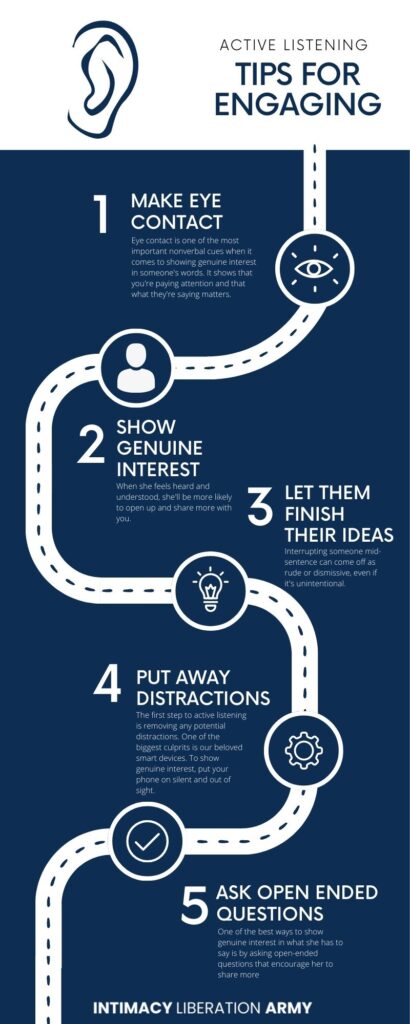The Art of Active Listening: Showing Genuine Interest in Her
The Power of Active Listening
When it comes to building strong relationships, active listening is a crucial skill. By actively listening, you show the other person that you value their thoughts and feelings, which can help build trust and strengthen your connection. On the other hand, failing to listen can damage even the strongest relationships.

Active listening means fully engaging with what the other person is saying without distractions or interruptions. It involves not only hearing their words but also understanding their perspective and emotions.
While it may sound simple enough, active listening requires effort and practice. But with time and dedication, it can become a natural part of your communication style.
Show Genuine Interest in What She Has to Say
One way to demonstrate active listening is by showing genuine interest in what she has to say. This means taking a sincere curiosity in her thoughts and feelings rather than just waiting for your turn to speak.
When she feels heard and understood, she’ll be more likely to open up and share more with you. To show genuine interest, start by putting away any distractions like phones or laptops that may pull your attention away from the conversation.

Make eye contact with her throughout the conversation to show that you’re engaged in what she’s saying. Nodding occasionally or using other nonverbal cues like smiling or leaning forward can also signal that you’re interested in what she has to say.
Avoid interrupting her while she’s speaking or finishing her sentences for her as this can come across as dismissive or disrespectful of her ideas. Instead, let her finish speaking before responding so that she knows you’ve heard everything she had to say.
Paying Attention
Put away distractions like phones and laptops
The first step to active listening is removing any potential distractions. One of the biggest culprits is our beloved smart devices. To show genuine interest, put your phone on silent and out of sight.
Resist the urge to check notifications or scroll through social media during a conversation. The other person will appreciate that you’re fully present and not mentally elsewhere.
If you’re in an environment with other sources of distraction, like a noisy coffee shop or television playing in the background, try to find a quieter spot where you can focus on the conversation. Remember, active listening means being fully engaged in the moment and actively participating.

Make eye contact and nod to show you’re engaged
Eye contact is one of the most important nonverbal cues when it comes to showing genuine interest in someone’s words. It shows that you’re paying attention and that what they’re saying matters. Keep your eyes focused on theirs, but don’t stare too intensely – use natural blink rates as your guide for how much eye contact is appropriate.
Nodding also signals engagement and understanding while providing encouragement for them to continue speaking freely without worry of interruption or disinterest from their listener. It’s important that your body language aligns with your attentive verbal responses so they feel heard and understood.
Avoid interrupting or finishing her sentences
Interrupting someone mid-sentence can come off as rude or dismissive, even if it’s unintentional. This is not very art of active listening of you. The person might feel like what they have to say isn’t important enough for you to wait for them to finish their thought. Similarly, finishing her sentences before she has a chance could make her feel like you’re trying to rush through the conversation or that she’s not capable of expressing herself clearly enough without help from others.

Instead, let her finish her thought before responding. This shows respect and allows for a more natural flow of conversation.
If you’re unsure of what she means, ask for clarification or further explanation. By giving her space to express herself fully, you’ll be showing genuine interest in what she has to say and developing a deeper connection.
Asking Questions
One of the best ways to show genuine interest in what she has to say is by asking open-ended questions that encourage her to share more. Use Open-ended questions that you can’t answer with a simple “yes” or “no,” but require a more detailed response.
For example, instead of asking “Did you have a good day?” try asking “What was the highlight of your day today?” This will show her that you want to hear more and are genuinely interested in what she has to say. In addition, it’s important to clarify any misunderstandings or confusion that may arise during the conversation.

If she says something that you don’t quite understand, ask for clarification rather than making assumptions. This will not only help you better understand what she’s trying to say, but also shows her that you’re actively listening and trying to comprehend her perspective.
Show Empathy by Reflecting on Her Emotions
Another way to show you’ve mastered The art of active listening and genuine interest in what she has to say is by reflecting on her emotions. Empathy is the ability to understand and share the feelings of another person.

When she shares something with you, try putting yourself in her shoes and imagining how she might be feeling. Then, reflect back on those emotions by saying something like “That sounds really frustrating,” or “I can imagine how happy that must have made you feel.”
Reflecting on her emotions not only shows empathy and understanding, but also encourages her to share even more about how she’s feeling. It creates a safe space for her to open up without fear of judgement or criticism.
Asking open-ended questions, clarifying misunderstandings, and reflecting on her emotions are all important ways of showing genuine interest in what she has to say during a conversation. These techniques help build stronger relationships and show her that you care about what she has to say and how she’s feeling.
Paraphrasing and Summarizing
Sometimes, when someone is talking to us, we might not fully understand what they’re saying. Rather than nodding along and pretending to know what they mean, active listeners try to clarify any misunderstandings by paraphrasing or summarizing the speaker’s words. Paraphrasing involves repeating back what someone said but using your own words.
This The Art of Active Listening technique helps ensure that you have understood their message correctly. For instance, suppose your partner says: “I’m feeling anxious about my upcoming job interview.” You can paraphrase this statement by saying something like: “So you’re nervous about your job interview?”.
Paraphrasing helps the other person feel heard and understood, which is essential for building a strong connection in any relationship. It can show that you are actively engaged in the conversation. It show’s you’re willing to make an effort to understand their point of view.
Summarizing is another technique you can use. In a conversation, you need to restate the main points of what has been discussed so far.
If you’ve been paying attention throughout the conversation, summarizing should be relatively easy; it can help show that you were actively listening throughout. Suppose your partner has just finished talking about their day at work; you could summarize by saying something like:
“So let me make sure I understood everything correctly – You had a frustrating meeting with your boss in the morning which put you in a bad mood for the rest of the day.”
This confirms that not only have you listened attentively but also that you remember key details from earlier in the conversation.
Nonverbal Cues
The Art of Active Listening involves more than just hearing the words someone says. It’s also about showing that you’re genuinely interested in what they have to say. It shows you care about their thoughts and feelings.
Nonverbal cues can be an incredibly effective way to do this, as they demonstrate engagement without interrupting the speaker. One important nonverbal cue is smiling.
Smiling not only signals happiness and positivity, but it also conveys interest in the conversation at hand. When someone sees a smile on your face, it gives them an emotional boost and encourages them to keep talking.
So, make sure to smile when appropriate during the conversation. It could make all the difference in how engaged she feels. Nodding is another effective nonverbal cue that demonstrates active listening.
Nodding shows agreement or acknowledgement with what the speaker is saying. They’ll feel like you care about their statement or question or interested in their point of view. However, be careful not to nod too much as it can become distracting. It can look like you’re simply waiting for your turn to talk. You’ll look disengaged, instead of actively listening to her story or idea.
Additionally, leaning in towards her shows that you’re invested in what she’s saying – both physically and mentally. It also helps convey a sense of intimacy and connection which can help build rapport between you two.
Avoid crossing your arms or looking away during the conversation as these may signal disinterest or boredom. It can look that way, even if that’s not how you feel! Instead, maintain eye contact throughout the conversation to show that you are present and engaged with her story.
Conclusion
The Art of Active Listening is a key aspect of any successful relationship, whether it’s with a romantic partner, family member, or friend. Pay attention. Ask questions. Use nonverbal cues to show genuine interest, you can strengthen your connection and build trust with others. It’s not always easy to master these skills, but the effort is well worth it.
One of the most important things to remember when practicing active listening is that it takes time and practice. Don’t beat yourself up if you struggle at first – just keep trying!
Over time, you’ll get better at focusing on what the other person is saying. You’ll begin responding in a way that shows you’re engaged. By actively listening and showing genuine interest in what she has to say, you’ll win. You’ll be able to form deeper connections with the people in your life.
This can lead to greater understanding, empathy, and even love. So take the time to practice active listening skills today – your relationships will thank you for it!






4 Comments